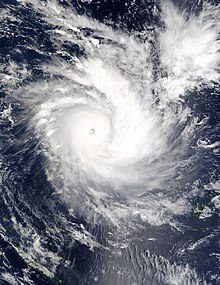Our website is made possible by displaying online advertisements to our visitors.
Please consider supporting us by disabling your ad blocker.
Cyclone Zoe
 Cyclone Zoe near peak intensity on December 27 | |
| Meteorological history | |
|---|---|
| Formed | December 23, 2002 |
| Extratropical | January 2, 2003 |
| Dissipated | January 4, 2003 |
| Category 5 severe tropical cyclone | |
| 10-minute sustained (FMS) | |
| Highest winds | 240 km/h (150 mph) |
| Lowest pressure | 890 hPa (mbar); 26.28 inHg |
| Category 5-equivalent tropical cyclone | |
| 1-minute sustained (SSHWS/JTWC) | |
| Highest winds | 285 km/h (180 mph) |
| Lowest pressure | 879 hPa (mbar); 25.96 inHg |
| Overall effects | |
| Fatalities | None |
| Areas affected | Solomon Islands, Fiji, Vanuatu, Rotuma |
| IBTrACS | |
Part of the 2002–03 South Pacific cyclone season | |
Severe Tropical Cyclone Zoe was the second-most intense tropical cyclone on record within the Southern Hemisphere and was the strongest tropical cyclone worldwide in 2002. The system was first noted on December 23, 2002, as a tropical depression that had developed, within the South Pacific Convergence Zone to the east of Tuvalu. Over the next couple of days, the system moved southwestwards and crossed the International Dateline early on December 25. After this, the system became better organized and was declared to be a tropical cyclone and named Zoe later that day. Zoe subsequently rapidly intensified in very favorable conditions as it continued to move west-southwest towards the Solomon Islands. The system subsequently became a Category 5 tropical cyclone on both the Australian tropical cyclone intensity scale and the Saffir-Simpson hurricane wind scale on December 27. The system subsequently affected the Solomon Islands Temotu Province during that day, before it peaked with 10-minute sustained wind speeds of 240 km/h (150 mph). As the system peaked, it performed a small clockwise cyclonic loop within the vicinity of Tikopia island, as a result of the steering flow over the cyclone becoming weak and variable. The system subsequently started to move towards the southeast during December 29, in response to a strengthening steering flow, provided by an upper level trough of low pressure and a baroclinic system near New Caledonia. Over the next few days the system weakened and degenerated into a tropical depression during January 1, 2003. The system was subsequently last noted during January 4, while it was located to the southeast of New Caledonia.
Cyclone Zoe severely affected areas of Rotuma, the Solomon Islands, and Vanuatu. Heavy rainfall and strong winds were particularly disastrous to the Solomon Islands, especially on the islands of Anuta and Tikopia. There, numerous crops and fruit–bearing trees were destroyed. Beaches were also heavily eroded due to the high waves generated by the cyclone. Although effects were lesser in Vanuatu, the country's northernmost islands experienced heavy flooding and beaches destroyed by high waves. After this usage of the name Zoe, the name was retired.
Previous Page Next Page


